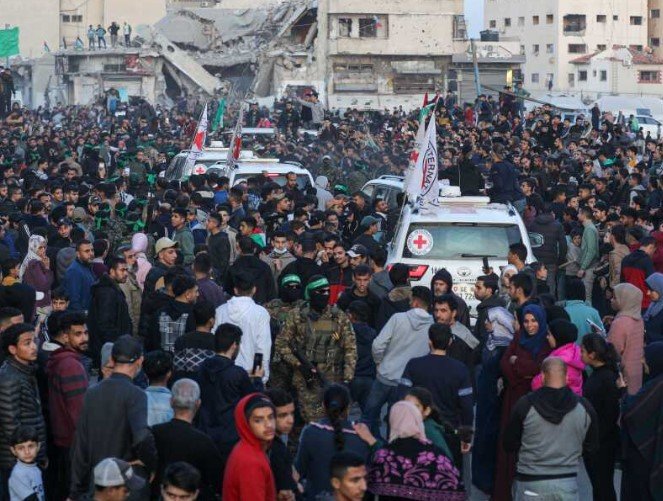In a key development amid the ongoing Gaza ceasefire, Hamas transferred the remains of what is believed to be a deceased hostage to the Red Cross on October 27, 2025. Israeli authorities received the body and are now working to confirm its identity, marking the first such handover in six days as pressure mounts from both Israel and the United States to speed up the process.
Ceasefire Deal Pushes for Quick Returns
The ceasefire agreement, brokered by the U.S. and effective from October 10, 2025, requires Hamas to return all remaining hostages, both living and deceased, within a tight timeframe. So far, Hamas has released all 20 living captives, but progress on the 28 bodies has been slow, with only 15 returned before this latest handover.
Israeli Prime Minister Benjamin Netanyahu’s office confirmed the transfer, noting that the coffin was handed to Israeli forces inside Gaza. Families of the hostages have urged both sides to pause any truce delays and focus on completing the returns. This comes after warnings from U.S. officials, including President Donald Trump, who stated that Israeli forces could resume operations if Hamas fails to comply fully.
If the body is identified as a hostage, the number still held in Gaza would drop to 12. Reports indicate the remains were found in Gaza City’s Tuffah neighborhood during a search operation.

Hamas claims it is expanding searches across Gaza, with help from an Egyptian team, to locate more remains. Under the deal, Israel has agreed to exchange 15 Palestinian bodies for each hostage body returned.
Details of the Handover Process
The Red Cross played a central role in the transfer, collecting the coffin from Hamas and delivering it to Israeli troops. A brief military ceremony followed, where soldiers draped the casket in an Israeli flag and a rabbi led prayers.
This process mirrors earlier handovers, such as the return of four bodies on October 14, 2025, and two more a week later, including the oldest hostage, an 85-year-old man. Forensic experts at Israel’s Abu Kabir Institute are handling identification to ensure accuracy.
Past exchanges have not always been straightforward. In some cases, bodies turned over by Hamas were later found not to belong to hostages, leading to added scrutiny and delays.
Here is a quick overview of the handover steps:
- Hamas notifies the Red Cross of a body recovery.
- Red Cross vehicles collect the remains in Gaza.
- Transfer occurs at a secure site inside the Strip.
- Israeli military inspects and conducts a ceremony.
- Body moves to Israel for forensic analysis.
Mounting Pressure and Warnings
Israeli officials have accused Hamas of delaying the returns to gain leverage, despite the group’s claims of ongoing searches. On October 27, 2025, a senior Hamas source mentioned coordination with the Red Cross for the latest transfer, but progress has stalled since the initial wave.
U.S. involvement has intensified, with reports suggesting openness to Israel expanding controlled areas in Gaza to pressure Hamas. This follows a pattern of diplomatic pushes, including Trump’s statement that fighting could restart “as soon as I say the word” if the deal falters.
Families of hostages have formed associations to advocate for faster action. One group demanded Hamas accelerate transfers after the release of living captives slowed the process.
| Key Figures in Hostage Returns | Details |
|---|---|
| Living hostages released | 20 |
| Deceased bodies returned so far | 16 (including latest) |
| Bodies still in Gaza (if latest confirmed) | 12 |
| Exchange ratio | 15 Palestinian bodies per hostage body |
| Ceasefire start date | October 10, 2025 |
Impact on Families and Broader Conflict
The slow pace has deepened anguish for families waiting for closure. Many have shared stories of loved ones taken during the October 7, 2023, attacks, highlighting the human cost of the delay.
This handover occurs against a backdrop of fragile peace. Recent events, like the expansion of searches in southern Gaza areas such as Khan Younis, show efforts to comply, but trust remains low.
Analysts point to logical reasons for delays, including the challenges of searching war-torn areas. Yet, with 12 potential bodies left, the focus is on whether this will lead to full resolution or renewed tensions.
Looking Ahead in the Ceasefire
Experts believe completing the returns could strengthen the truce, but any missteps might unravel it. Israel has prepared contingency plans, while international mediators push for adherence.
As identification proceeds, attention turns to the remaining captives. This development offers hope but underscores the need for continued diplomacy.
Share your thoughts on this unfolding story in the comments below, and pass this article along to keep others informed about the latest in the Gaza ceasefire.
